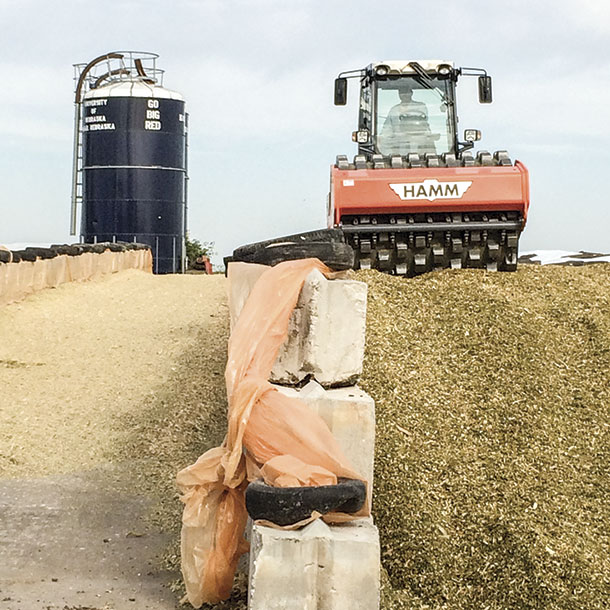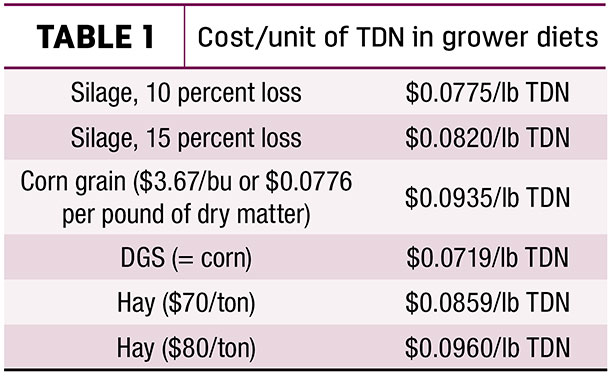Corn silage is a high-quality feedstuff that allows you to capture high-moisture corn and a roughage source that can be used in all aspects of the beef cattle industry – feeding cows in confinement, growing cattle and finishing cattle in feedlots.
There are considerable amounts of data on feeding corn silage; however, the real question is how to price it. Asking producers to properly (if that is actually possible) price silage can be a difficult conversation to have but, based on recent findings, pricing silage is quite complex and requires some extensive calculations.

Every operation is different and, based on research conducted at the University of Nebraska – Lincoln, we will try to provide data to help price corn silage. Corn silage has typically been priced on the value of the corn grain in the field. We believe there are two issues that need careful consideration.
First is the time of pricing the corn, and second is consideration of the nutrient value of the manure produced.
Four finishing experiments were conducted where corn silage was fed at 15 percent of diet dry matter to supply roughage (about 7.5 percent) versus silage fed at 45 percent of the diet. The number of days on feed was adjusted to achieve the same total gain.
The cattle fed 45 percent silage gained slower and less efficiently, and took more days and more feed. These data are used for the economic calculations. In addition, getting an accurate price is critical to know whether feeding silage is still economical given that some gain and efficiency is lost. As you will see, if price is accurate, then using silage can be quite economical.
Pricing based on corn grain value
Silage is priced based on the value of the corn grain in the field. Corn price increases from harvest to the following summer and is roughly equivalent to storage costs, around 47 cents per bushel (on a 10-year average) or approximately 5 cents per bushel per month.
If the corn is not cut for silage, then storage cost of the grain must be considered. Therefore, we are pricing corn based on fall price in the field and not paying for storage costs.
For the following calculations, we are using the fall futures ($3.82 per bushel) price minus the basis (eastern Nebraska = 39 cents). The net in the field is $3.43 cash price minus costs for harvest, hauling, drying and losses, which comes to $2.96 per bushel.
Assuming we have 225 bushels per acre of corn, we have a value of $666.90 per acre or $125 per ton of corn grain. We calculated from hand harvest and field trials an average 26.31 tons per acre as-is, which prices the silage at $25.35 per ton for 38 percent dry matter silage.
Manure credits in finishing diets
Standing in the field, the corn silage is priced at $25.35 per ton plus residue value of $1.93, which is equivalent to the amount of nitrogen (N) and phosphorus (P) left on the field in the plant residue after grain harvest. Then we added harvesting, hauling and packing costs of $11 per ton, plus storage cost of $2 per ton, plus a 10 percent shrink of $4.20 per ton, which equals $44.48 per ton in the bunker.
In the past, the value of the plant nutrients in the forage part of the silage has been charged against the silage at fertilizer prices. No consideration has been given to the plant nutrients in the manure resulting from feeding the silage. We believe the plant nutrients in the manure should also be valued at fertilizer prices.
When we account for the value of N (41 cents per pound) and P (81 cents per pound) in the manure from the corn silage, we get a credit that reduces the silage cost.
The manure credit includes P at about four times the level needed for annual plant growth. Rotating fields and spreading the manure one out of every four years is the most economical alternative. With spreading the manure on each field one out of four years, we credit $3.50 per ton of silage, and spreading cost would be 71 cents per ton.
This would price our corn silage in the bunker at $41.69 per ton. When spreading manure one out of every four years, corn silage is priced at 70 to 74 percent the price of corn. Based on the economic analysis, when corn silage is priced less than 80 percent the price of corn grain, it is a good buy and should be considered in finishing diets.
Accounting for shrink
When evaluating pricing scenarios, we varied manure credits and shrink in the bunker. Silage price varied from 52 percent the price of corn to 80.4 percent the price of corn. Minimizing shrink by 5 percent could save $1.81 per head during the entire feeding period when corn silage is fed at 15 percent of the diet. At 45 percent inclusion of corn silage, minimizing shrink had a savings of $5.15 per head over the entire feeding period.
When feeding elevated levels of corn silage, managing shrink becomes more important. By not accounting for manure credits, we are giving up $3.50 per ton of silage in finishing cattle. At 15 percent corn silage inclusion, that is a difference of $2.56 per head, and at 45 percent corn silage inclusion, that is a difference of $7.92 per head between accounting for manure value or not.
Manure credits from grower-cattle diets
When considering corn silage use in growing diets, lighter cattle fed a growing diet produce fewer manure nutrients, which affects price and returns but still offers opportunities. All of the silage costs above are also relevant for growing cattle, except the net manure credit is now $1.33 per ton; this brings total cost in the bunker to $43.86 per ton.
While this is a higher cost than in finishing diets, final silage price is still at 72 to 76 percent the cost of corn, depending upon the amount of silage shrink.
In a 74-day growing trial, cattle gained 275 pounds on an 80 percent corn silage diet and had an average cost of gain of 50 cents per pound with a 10 percent shrink on the corn silage. If we increase shrink 5 percent, we increase cost of gain to 52 cents per pound, which equates to $5.50 per head saved by managing shrink.
When we look at the growing diets on a cost per pound of total digestible nutrients (Table 1), we see the best-priced feedstuffs are distillers grains and corn silage.

When corn is $3.67 per bushel, corn silage is priced 83 to 88 percent the price of corn per unit of total digestible nutrients. This table suggests corn silage supplemented with distillers grains is an economical way to grow calves in the feedlot. The combination of these two ingredients could also be economical in many beef systems, including for limit-feeding cows in confinement.
When pricing corn silage accurately, the opportunity for economic returns depends on what class of cattle are being fed, inclusion and manure reutilization of nutrients valued at fertilizer price. For finishing cattle, there are two important issues: manure credit and silage shrink.
Based on numerous pricing scenarios, feeding silage with distillers grains is a very economical way to grow cattle in the feedyard, assuming shrink is managed well at the time of ensiling. Numerous management options are available to manage shrink. ![]()
PHOTO: When pricing corn silage accurately, the opportunity for economic returns depends on what class of cattle are being fed, inclusion and manure reutilization of nutrients valued at fertilizer price. Photo provided by Henry Hilscher.
For more information, please visit UNL Beef Newsletter or visit with our extension personnel at the University of Nebraska-Lincoln.
Dirk Burken is a former research feedyard manager; Andrea Watson, Galen Erickson, and Terry Klopfenstein are faculty members with University of Nebraska – Lincoln.













